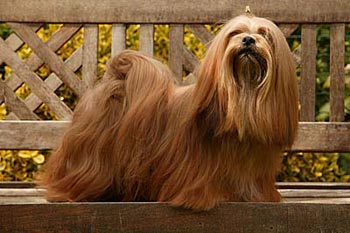Lhasa Apso on:
[Wikipedia]
[Google]
[Amazon]
The Lhasa Apso ( ) is a non-sporting




 A 2004 Kennel Club survey puts the median lifespan of the breed at 14 years 4 months. UK vet clinic data puts the median at 13.0 years.
A 2004 Kennel Club survey puts the median lifespan of the breed at 14 years 4 months. UK vet clinic data puts the median at 13.0 years.
dog breed
A dog breed is a particular strain of dog that was purposefully bred by humans to perform specific tasks, such as herding, hunting, and guarding. Dogs are the most variable mammal on Earth, with artificial selection producing around 450 global ...
originating in Tibet
Tibet (; ''Böd''; ) is a region in East Asia, covering much of the Tibetan Plateau and spanning about . It is the traditional homeland of the Tibetan people. Also resident on the plateau are some other ethnic groups such as Monpa people, ...
. It has traditionally been used as an interior sentinel.
Etymology




Lhasa
Lhasa (; Lhasa dialect: ; bo, text=ལྷ་ས, translation=Place of Gods) is the urban center of the prefecture-level Lhasa City and the administrative capital of Tibet Autonomous Region in Southwest China. The inner urban area of Lhas ...
is the capital city of Tibet, and ''apso'' is a word from the Tibetan language. There is some debate over the exact origin of the name; some claim that the word "apso" is an anglicized form of the Tibetan word for goatee ("ag-tshom", ཨག་ཚོམ་) or perhaps "ra-pho" (ར་ཕོ་) meaning "billy goat". It may also be a compound noun meaning "bark-guard" (lit. "ap" ��པ to bark, and "so" ��ོ་ to guard).
History
The Lhasa Apso originated inTibet
Tibet (; ''Böd''; ) is a region in East Asia, covering much of the Tibetan Plateau and spanning about . It is the traditional homeland of the Tibetan people. Also resident on the plateau are some other ethnic groups such as Monpa people, ...
. In the early twentieth century some Tibetan dogs were brought to the United Kingdom by military men returning from the Indian subcontinent. These were of mixed types, similar either to what would become the Lhasa Apso or to what would become the Tibetan Terrier
The Tibetan Terrier is a medium-sized breed of dog that originated in Tibet.American Kennel Club (2013). '' Get to know the Tibetan Terrier.'' Retrieved from http://www.akc.org/breeds/tibetan_terrier/index.cfm Despite its name, it is not a membe ...
; they were collectively known as "Lhasa Terrier".
The original American pair of Lhasas was a gift from Thubten Gyatso, 13th Dalai Lama to C. Suydam Cutting, arriving in the United States
The United States of America (U.S.A. or USA), commonly known as the United States (U.S. or US) or America, is a country primarily located in North America. It consists of 50 U.S. state, states, a Washington, D.C., federal district, five ma ...
in 1933. Mr. Cutting had traveled to Tibet and met the Dalai Lama. At the time, there was only one Lhasa Apso registered in England. The American Kennel Club
The American Kennel Club (AKC) is a registry of purebred dog pedigrees in the United States. In addition to maintaining its pedigree registry, this kennel club also promotes and sanctions events for purebred dogs, including the Westminster ...
officially accepted the breed in 1935 in the Terrier Group, and in 1959 transferred the breed to the Non-Sporting Group. In the UK, they are placed in the Utility Group.
The breed was definitively accepted by the Fédération Cynologique Internationale
The Fédération cynologique internationale (FCI) ( English: International Canine Federation) is the largest international federation of national kennel clubs. It is based in Thuin, Belgium.
History
The FCI was founded in 1911 under the auspice ...
in 1960.
Characteristics
Dogs stand about at thewithers
The withers is the ridge between the shoulder blades of an animal, typically a quadruped. In many species, it is the tallest point of the body. In horses and dogs, it is the standard place to measure the animal's height. In contrast, cattle ...
, bitches slightly less. The coat may be black, brownish, dark grizzle, golden, honey, parti-colour, sandy, slate-coloured, smoke-coloured or white. It is thick and heavy, with a hard straight outer coat and a medium under-coat. The eyes are dark and the nose is black, and the ears are pendant. The tail is curved, sometimes with a kink at the tip, and should be carried over the back.
It ranks 68th (out of 138) in Stanley Coren's '' The Intelligence of Dogs'', having fair working-obedience intelligence. The Lhasa Apso is a long-lived breed, with many living in good health into their early 20s.
 A 2004 Kennel Club survey puts the median lifespan of the breed at 14 years 4 months. UK vet clinic data puts the median at 13.0 years.
A 2004 Kennel Club survey puts the median lifespan of the breed at 14 years 4 months. UK vet clinic data puts the median at 13.0 years.
References
{{Chinese dogs Companion dogs Dog breeds originating in Tibet FCI breeds